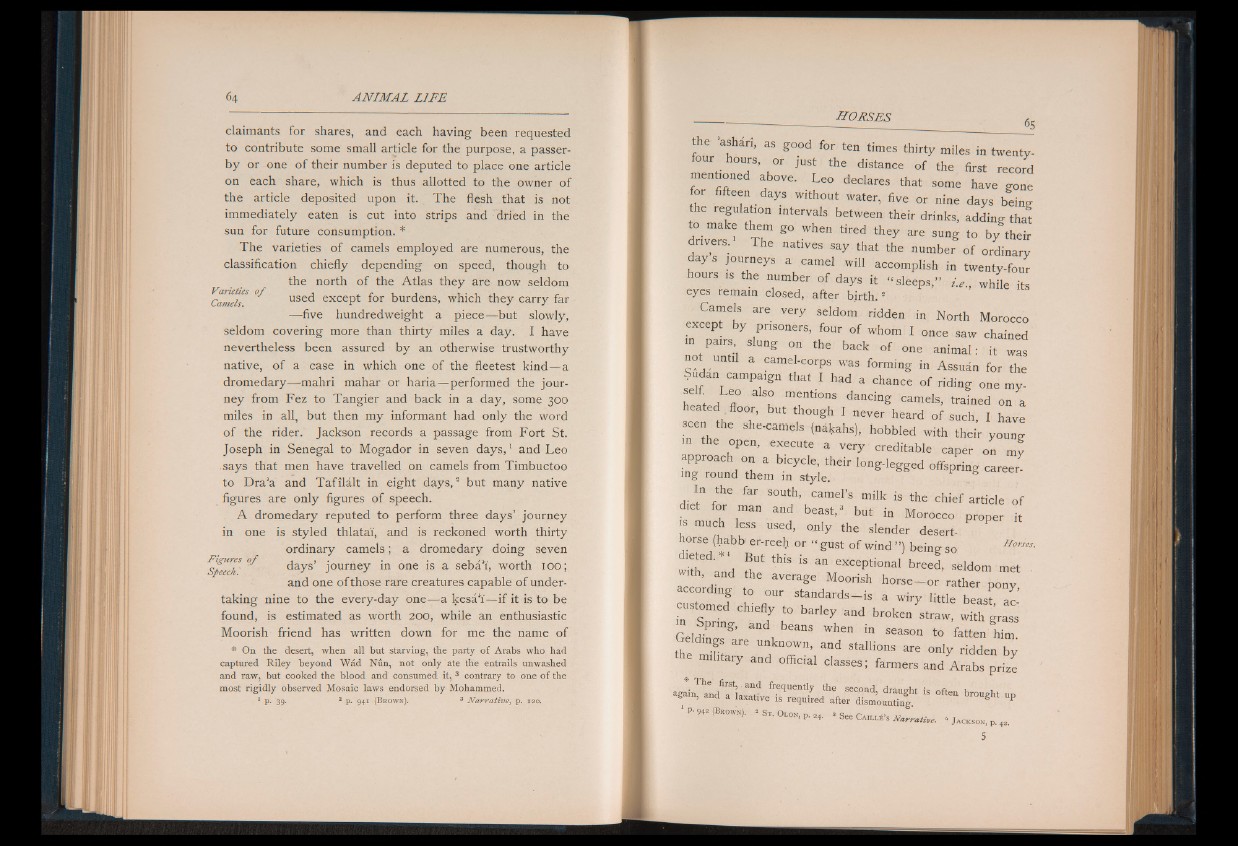
claimants for shares, and each having been requested
to contribute some small article for the purpose, a passerby
or one o f their number is deputed to place one article
on each share, which is thus allotted to the owner of
the article deposited upon it. The flesh that is not
immediately eaten is cut into strips and dried in the
sun for future consumption. *
The varieties of camels employed are numerous, the
classification chiefly depending on speed, though to
the north o f the Atlas they are now seldom
VdFtetzeS o f ,
Camels used except for burdens, which they carry far
— five hundredweight a piece— but slowly,
seldom covering more than thirty miles a day. I have
nevertheless been assured by an otherwise trustworthy
native, of a case in which one of the fleetest kind— a
dromedary— mahri mahar or haria— performed the journey
from Fez to Tangier and back in a day, some 300
miles in all, but then my informant had only the word
o f the rider. Jackson records a passage from Fort St.
Joseph in Senegal to Mogador in seven day s,1 and Leo
says that men have travelled on camels from Timbuctoo
to Dra'a and Tafilalt in eight days,2 but many native
figures are only figures of speech.
A dromedary reputed to perform three days’ journey
in one is styled thlataf, and is reckoned worth thirty
ordinary camels; a dromedary doing seven
Figures o f A , . . . i>>*
Speech days journey in one is a sebai, worth 100;
and one of those rare creatures capable of undertaking
nine to the every-day one— a kesa’i—if it is to be
found, is estimated as worth 200, while an enthusiastic
Moorish friend has written down for me the name of
* On the desert, when all but starving, the party of Arabs who had
captured Riley beyond W£d Nun, not only ate the entrails unwashed
and raw, but cooked the blood and consumed it, 3 contrary to one of the
most rigidly observed Mosaic laws endorsed by Mohammed.
1 P- 39* 2 p. 941 • (Brown). 3 Narrative, p. 120.
the ‘aslmri, as good for ten times thirty miles in twenty,
four hours, or just the distance of the first record
mentioned above. Leo deciares that some have gone
for fifteen days without water, five or nine days being
regulation intervals between their drinks, adding that
rivTs ' xTe g ° tWhe” tirKi drivers. The natives say tha,th 'thye num*be*r o«f0 obrd/tinhaeriyr
day s journeys a camel will accomplish in twenty-four
hours ,s the number o f days it ..s le ep ,,- L ) while ft,
eyes remain closed, after birth.2
arC Very seldom r'dden in North Morocco
except by prisoners, four of whom I once saw chained
pairs slung on the back of one animal: it was
not until a camel-corps was forming in Assuan for the
Sudan campaign that I had a chance o f riding one myself
Leo also mentions dancing camels, trained on a
heated^ floor, but though I never heard of such, I have
seen the she-camels (nakahs), hobbled with their young
1 1 1 T CUte " H Cr6ditable - P - on my
approach on a bicycle, their long-legged offspring careering
round them in style. .
In the far south, camel’s milk is the chief article of
diet for man and beast,3 but in Morocco proper it
s much less used, only the slender desert-
horse (habb- er-reeh or “ gust o f wind ” ) being- so Horsesd
>t,ed a ^Ut I 1S an excePrional breed, seldom met
with, and the average Moorish h o r s e -o r rather pony
according to our standards-is a wiry little beast ac’
3 » t barleyand brok“ ’ ^ ^
O ld ' nS n m season to fatten him
eldings are unknown, and stallions are only ridden by
Masses; farmers aud Arab,“ rfte
1 °f“ -
P- 942 (Brown). * S t . Olon, p. 3 See C a i l l e ’s /v A u ,
ee '-AILI-E s Narrative. 1 J a c k s o n , p. +2.
s